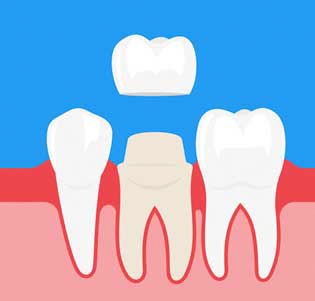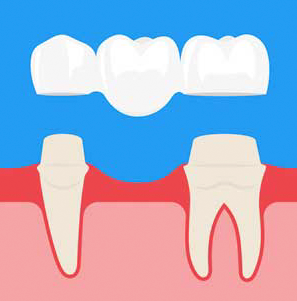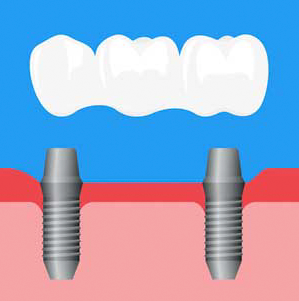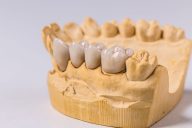PROSTHODONTIC TREATMENT
Fixed prosthodontics
Crowns & bridges
Crowns and bridges are types of prosthodontic tooth restorations.
A crown covers the chewing surface and lateral surfaces of a damaged tooth that is above the gum line.
A dental bridge consists of artificial teeth attached to adjacent teeth, restoring the “gap” in between where a natural tooth/teeth have been removed.
Both methods are effective at restoring multiple missing teeth and emulating the shape, color, and function of natural teeth.
Metal-ceramic crowns are constructed of an internal metal alloy covered by a layer of ceramic. They show excellent durability, good aesthetics and can be used to restore both anterior and posterior teeth. They are more economical compared to all-ceramic and zirconium crowns, but they are significantly inferior in terms of aesthetic performance.
All-ceramic crowns are composed entirely of porcelain. Because of their transparency, all-ceramic crowns can resemble the natural tooth almost perfectly and have an excellent aesthetic performance. They are mainly used for anterior tooth restorations because of their good aesthetics. However, porcelain is not as strong as other dental materials and is therefore not preferred for posterior teeth that experience high amounts of chewing force or in patients who grind their teeth or clench their jaws at night.
Zirconia-based crowns have a zirconium-oxide framework covered by porcelain. Because of the zirconium-oxide framework’s excellent resistance to chewing forces, its white color allows light to pass through the porcelain. Zirconia crowns are used for restorations of both anterior and posterior teeth because they combine the high resistance of metal ceramic crowns and the excellent aesthetics of all ceramics.
DENTAL PROSTHETICS

Crown
over natural tooth

Bridge
over natural teeth

Crown
over implant

Bridge
over implants
In which cases will i need a crown / bridge ?
- Extensive decay:
When teeth have been so damaged by decay that a filling or a crown is not considered a suitable treatment option, crowns may be the best choice. - Endodontically treated teeth:
They are very prone to fracture. In cases where a large part of the dental substance has also been lost, then it is best to place a crown over the tooth in order to protect it from an eventuality fracture, which can eventually lead us to extract the tooth. - Cracked teeth:
They should be protected by using a crown to keep the crack from spreading and becoming a fracture, thereby requiring possible extraction. - Fractured teeth:
When a tooth has been broken and a large portion of the tooth’s root has been lost, it cannot be restored by a filling. In these cases, endodontic treatment (removal of the pulp) and placement of an endodontic post are often required before placing a crown on the tooth.
Frequently asked questions
Indications
- In teeth with extensive obturations (fillings).
- In endodontically treated teeth.
- In teeth with crown fractures.
- In teeth with extensive abrasion either due to age or due to chemical factors (carbonated drinks, acidic juices, vomit acids).
- To modify the shape of the tooth in order to accept a partial denture.
Advantages
- Excellent durability and application due to the underlying metal frame.
- Aesthetics quite good due to the overlying porcelain that fully reproduces the natural morphology of the teeth.
Disadvantages
- Extensive preparation (grinding) of the hard dental tissues for the metal and porcelain to provide the combined strength and aesthetics.
- With the passage of time and the receding of the soft tissues (gums), an unsightly metallic “edge” appears at the border of the gums which corresponds to the border of the metal frame of the crown and which was ‘hidden’ inside the soft tissues (gingival fissure).
- The lifespan of metal-ceramic crowns can reach up to 10-15 years, provided that the patient practices effective oral hygiene and regular check-ups are carried out.
Prerequisites
- Absence of inflammation in the form of gingivitis or periodontitis.
- Satisfactory bone support of the teeth that will support the bridge.
- Good oral hygiene.
Advantages
- They are fixed restorations permanently bonded to the patient’s oral cavity.
- They improve the function of chewing, speech and aesthetics.
- The movement of the adjacent teeth in the space is prevented, resulting in future occlusal disorders.
- They have very good aesthetics.
Disadvantages
- The preparation (grinding) of the teeth and the possible need to endodontically treat the supporting teeth.
- This disadvantage can be dealt with by placing implants.
The same as in zirconium crowns
It is the same thin as in metal-ceramic bridges, except that in this case the internal framework consists of zirconium, which is externally covered with porcelain.
In addition, they excel in aesthetics compared to metal-ceramic bridges as well as in cost, which is clearly higher.
Their placement is not indicated in brugmomaniac patients, i.e. those who grind or clench their teeth.

Removable prosthodontics
Total prosthesis (full dentures)
Dentures are used when all of the teeth of either the upper or lower jaw or both are missing. They consist of a pink-colored acrylic base made to simulate natural gum tissue, on which artificial teeth are attached.
Complete dentures are a fairly economical solution for completely edentulous patients. They contribute significantly to the self-confidence of edentulous patients both by improving their facial image and by helping them during the chewing process.
Advantages
- Chewing ability is restored
- Provides support for the lips and cheeks
- Correct the collapsed appearance that occurs after losing teeth.
- Improvement of pronunciation of words
- Aesthetic improvement, providing a more youthful look
- Restore the natural facial appearance
- Improve patients self-esteem
Partial prosthesis (partial dentures)
They replace missing teeth, preventing shifting of the remaining natural teeth and maintaining the shape of the mouth.
It is composed of artificial teeth attached to a pink or gum-colored base made of acrylic and rest on the remaining natural teeth. This base can be connected to a metal framework that holds the denture in place inside the mouth. Their support on the existing teeth is done with special connectors or simple clasps.
Partial dentures are an economical solution in cases where several teeth are missing on either side of the jaws. This base can be connected to a metal framework that holds the denture in place inside the mouth.
Types of Dentures we offer
- Acrylic witn metal clasps (conventional partial denture)
- Acrylic with metal cast framework
- Acrylic with acrylic clasps
- Bredent/Termosens/Valplast (soft ) acrylic denture with acrylic clasps
Advantages
- Improved eating function.
- Prevents the movement of the remaining teeth.
- Preserves the patient’s natural contour.
- Economic.
Frequently asked questions
Advantages
- Chewing ability is restored
- Provides support for the lips and cheeks
- Correct the collapsed appearance that occurs after losing teeth.
- Improvement of pronunciation of words
- Aesthetic improvement, providing a more youthful look
- Restore the natural facial appearance
- Improve patients self-esteem
- Fast and hassle-free process.
- Low cost.
Disadvantages
- Lack of stability and retention in cases of resorption of bone and overlying gums.
- Continued bone loss over time due to the use of the denture.
- A slight difficulty in speaking and chewing is to be expected immediately after the placement of the denture, which is why it is necessary the patients to show patience until they get used to it.
When handling during their cleaning, make sure to have a towel or a basin of water under your hands. Dentures are sensitive and can break if dropped on the floor or into the sink.
Do not let them dry out. When not wearing them, keep them in a glass of water or a special solution. Do not use hot water.
With daily brushing, remove food and plaque from all surfaces of the denture. There are special liquids for cleaning the dentures, but do not replace daily systematic brushing.
Brush your gums, tongue and palate with a soft toothbrush every morning before wearing the dentures and every night when remove them from your oral cavity. Brushing activates and improves blood circulation in your gums and underlying bone and removes plaque.
During the night it would be good to remove it from the oral cavity and keep it in water, after it has previously been meticulously cleaned.
Visit your dentist when your dentures break, crack or loosen. Do not try to fix them yourself because it can damage them irreparably.
Visit your dentist once a year for a check-up, in order for your dentist to check on the fit and the condition of your dentures and oral cavity.
Indications
- In cases where more than three teeth are missing in a row.
- For financial reasons because it is a cheaper solution compared to crowns, bridges and implants.
Advantages
- Improved eating function.
- Prevents the movement of the remaining teeth.
- Preserves the patient’s natural contour.
- Rehabilitation of the patient’s function (chewing and speech).
- Restoration and improvement of facial aesthetics.
- Fast and hassle-free process.
- Low cost.
Disadvantages
- A slight difficulty in speaking and chewing is to be expected immediately after the placement of the partial denture, which is why it takes patience on the part of the patients until they get used to it.
- A little practice is required to place and remove the partial denture.
- It can be removed from the oral cavity.
With daily brushing, remove food and plaque from all the surfaces of the partial denture. There are special liquids for partial denture cleaning, but do not replace daily systematic brushing.
Do not let them dry out. When you are not wearing them, they are preserved in water or in a special solution. Do not use hot water.
Brush your gums, tongue and palate with a soft toothbrush every morning before wearing partial dentures and every evening when you remove them from your oral cavity. Brushing activates and improves blood circulation in your gums and underlying bone and removes plaque.
During the night it would be good to remove the partial denture from the oral cavity and keep it in water, after it has previously been meticulously cleaned.
Be careful during the placement and removal of the partial denture from the oral cavity. This should be done simultaneously from the right and left side so that it does not distort its shape.
Visit your dentist when your partial dentures break, crack or loosen. Do not attempt to fix them as you may damage them irreparably.














